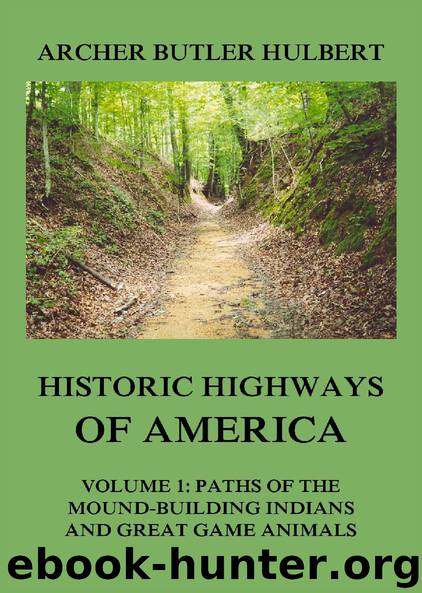Historic Highways of America: Volume 1: Paths of the Mound-Building Indians and Great Game Animals by Archer Butler Hulbert

Author:Archer Butler Hulbert [Hulbert, Archer Butler]
Language: eng
Format: epub
Tags: Geschichte
Publisher: Jazzybee Verlag
Published: 2018-04-09T22:00:00+00:00
CHAPTER V - WATERSHED MIGRATIONS
A FEW descriptions of the local roadways of the mound-building Indians have been cited; reasons for believing that they used the watersheds, to a greater or less degree, as highways for passage from one part of the country to another, have been described. Let us look at the matter of their migrations.
That these people did migrate there is no doubt among archaeologists. The many kinds of archaeological remains now found indicate that they were divided into many different tribes, and the great distances between works of similar character show that the various tribes labored at divers times in divers places. " The longest stretch where those apparently the works of one people are found on one bank [of the Mississippi river] is from Dubuque, Iowa, to the mouth of Des Moines river. As we move up and down [the Mississippi] we find repeated changes from one type to another."
The direction from which these mound-builders entered the regions where their works are found, and their migrations within this region, must be decided by a careful study of the varying character of the mounds and a classification of them.
This work has not been done, save in the most general way possible, though one highly important conclusion has been definitely reached. It is that the generally received opinion heretofore held by archaeologists that the lines of migration were along the principal water-courses is not found to be correct, and that these lines of migration were across the larger watercourses, such as the Mississippi, rather than up and down them.
" One somewhat singular feature is found in the lines of former occupancy indicated by the archaeological remains. The chief one is that reaching from New York through Ohio along the Ohio river and onward in the same direction to the northeastern corner of Texas; another follows the Mississippi river; another extends from the region of the Wabash to the headwaters of the Savannah river, and another across southern Michigan and southern Wisconsin. The inference, however, which might be drawn from this fact that these lines indicate routes of migration is not to be taken for granted. It is shown by the explorations of the Bureau, and a careful study of the different types of mounds and other works, that the generally received opinion that the lines of migration of the authors of these works were always along the principal water-courses, cannot be accepted as entirely correct. Although the banks of the Mississippi are lined with prehistoric monuments from Lake Pepin to the mouth of Red river, showing that this was a favorite section for the ancient inhabitants, the study of these remains does not give support to the theory that this great water highway was a line of migration during the mound-building period, except for short distances. It was, no doubt, a highway for traffic and war parties, but the movements of tribes were across it rather than up and down it This is not asserted as a mere theory
Download
This site does not store any files on its server. We only index and link to content provided by other sites. Please contact the content providers to delete copyright contents if any and email us, we'll remove relevant links or contents immediately.
Fanny Burney by Claire Harman(26240)
Empire of the Sikhs by Patwant Singh(22763)
Out of India by Michael Foss(16693)
Leonardo da Vinci by Walter Isaacson(12800)
Small Great Things by Jodi Picoult(6678)
The Six Wives Of Henry VIII (WOMEN IN HISTORY) by Fraser Antonia(5236)
The Wind in My Hair by Masih Alinejad(4839)
The Crown by Robert Lacey(4572)
The Lonely City by Olivia Laing(4568)
A Higher Loyalty: Truth, Lies, and Leadership by James Comey(4550)
The Iron Duke by The Iron Duke(4119)
Millionaire: The Philanderer, Gambler, and Duelist Who Invented Modern Finance by Janet Gleeson(4094)
Sticky Fingers by Joe Hagan(3911)
Papillon (English) by Henri Charrière(3902)
Joan of Arc by Mary Gordon(3782)
Alive: The Story of the Andes Survivors by Piers Paul Read(3730)
Stalin by Stephen Kotkin(3724)
Aleister Crowley: The Biography by Tobias Churton(3424)
Ants Among Elephants by Sujatha Gidla(3279)
